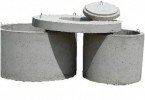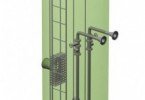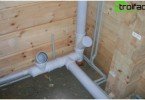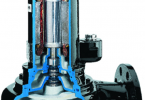Manhole
Sewerage system consists of many elements that ensure the overall coordinated operation of the network as a whole. The manhole in this case is the main building, carrying out not only a functional check, but also timely cleaning of the sewer collector. Thus, we can say that viewing wells are the central link in the external sewage system..
Content
- Types of Manholes
- Traditional construction of an important component of the sewage system
- Hatch Manufacturing Standards
- Intervals between inspection hatches
Types of Manholes
Depending on the purpose, it is customary to distinguish the following types of inspection wells:
- linear, installed on the straight sections of the entire sewer system at a distance that depends on the diameter of the pipes;
- rotary wells are located in places where the direction of the line changes, i.e. on bends. This type of well differs from the linear configuration of the tray, which has the shape of a smooth curve with the smallest curvature radius, which equals three pipe diameters. The angle of rotation must not exceed 90 degrees.
- nodal arrange at the connection points of several sewage lines. They have a tray unit connecting no more than one outlet and three inlet pipes. Nodal wells in large collector networks are called connecting chambers;
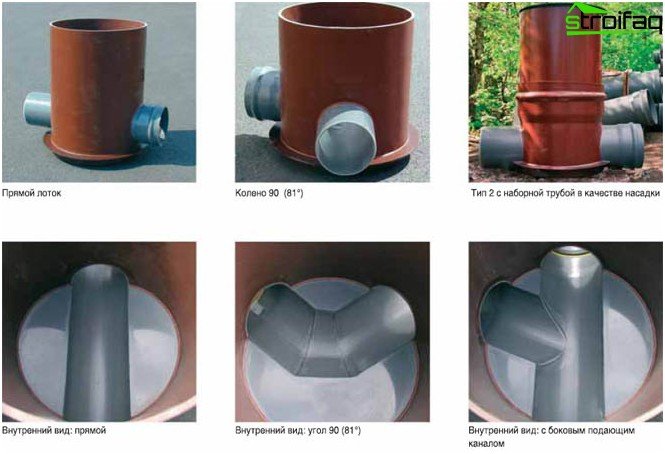
Types and types of manholes, depending on the internal structure of the pipeline
- control are carried out in parts of the connection of the factory, intra-quarter or courtyard network to the street, and they are placed outside the red line of the construction site – from the side of the houses. Wells of the control type are necessary to control the operation of the sewer system of the added facilities;
- flushing wells are needed for flushing the system in the primary (starting) areas where precipitation is possible due to low speeds;
- overflow wells are provided in areas where the mark of the tray of the discharge and supply pipes differs;
- special wells with enlarged neck and hatch dimensions are mounted on collectors 600 mm in diameter at a distance of more than 50 m from each other.
Traditional construction of an important component of the sewage system
Regardless of the type of inspection accessory drainage well consists of a base, a tray, a working chamber, a neck and a hatch.
Wells can be made of different materials: brick, reinforced concrete blocks, rubble stone.
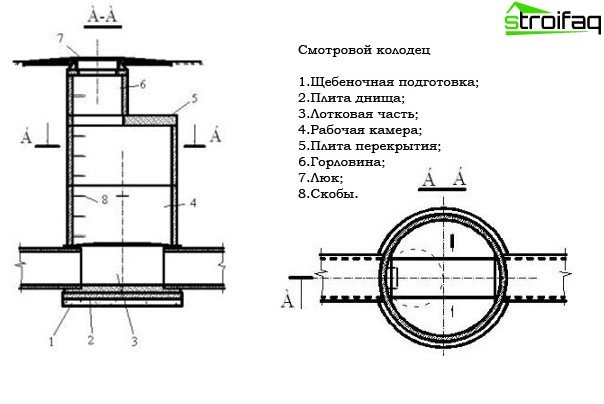
Manhole: Construction
On the diagram (plan), inspection wells are round, rectangular and polygonal. The base consists of a reinforced concrete slab, which is laid on crushed stone. The main technological part is the tray, which is made of monolithic concrete (M 200) using templates – formwork, followed by mashing the surface with iron or cementing.
The pipeline goes into the trough part, through which sewage flows. In linear wells, the chute part is rectilinear, and the surface in the lower part is vertical. The height of the tray is not less than the diameter of the larger pipe. On both sides of the tray berm (shelves) are formed, which must be given a slope of 0.02 in the chute side. Shelves perform the function of platforms on which workers are housed during operational activities.
Important! The working chamber should have the following dimensions: height 1800 mm, and the diameter depends on the diameter of the pipes. So at d 600 mm – 1000 mm; with d 800-1000 mm – 1500 mm; with d 1200 – 2000 mm.
The necks of the well are standard – 700 mm. With a pipe diameter of 600 mm, the necks must be installed so that they allow entry of cleaning devices (cylinders and balls). Necks and working chambers are equipped with hinged ladders or brackets for descent.
The transition to the neck is possible with the help of a conical part or a reinforced concrete block of overlapping. At ground level, the necks end with a hatch that can be light or heavy.
Important! Installation of hatches with improved road surface is carried out 70 mm from the earth’s surface – in the green zone; in an undeveloped area – 200 mm above the ground.
If the well is located on an uncoated area, then a blind area should be built around the hatch to drain water.
Hatch Manufacturing Standards
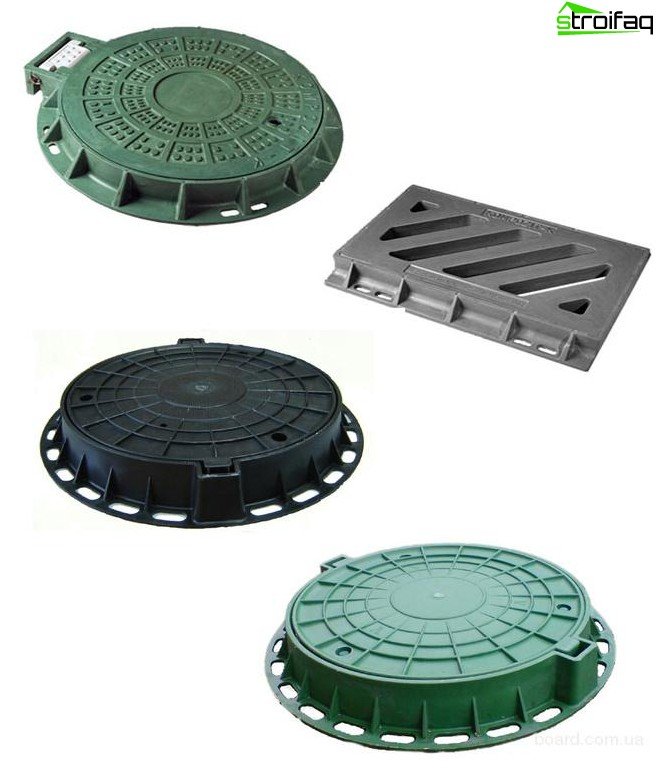
Plastic and cast iron manhole covers
At first glance, it may seem that the hatch is not such an important element of the manhole, but in fact it is not. The proof is the standards that must be observed in their manufacture. The main material is cast iron (GOST 3634-61). Cast iron hatches consist of a housing with one cover for installation on the neck with a diameter of 700 mm and with an opening for passage with a diameter of 620 mm. Heavy hatches are laid on the carriageway and have a mass of 134 kg, and light, stacked mainly on sidewalks, weigh no more than 80 kg.
Along with cast iron, polymeric materials are used for manufacturing, which are distinguished by strength, lightness, durability and environmental safety.
It is interesting! In the manufacture of polymer hatches, special fillers are added that make the processing process impossible. That is why such hatches are not of any interest to recyclable receivers..
Intervals between inspection hatches
When installing the device, it should be noted that the distance between the inspection wells of a linear type depends on the diameter of the pipe. It looks like this:
- d = 150 mm – 35 meters;
- d = 200 mm – 50 meters;
- d = 500 mm – 75 meters;
- d = 700-900 mm – 100 meters;
- d = 1000-1400 mm – 150 meters;
- d = 1500-2000 mm – 200 meters;
- d > 2000 – 300 meters.

The distance between adjacent manholes is strictly normalized.
Inspection wells are the main component of the sewer system, not only providing unhindered inspection and monitoring of urban pipelines, but also creating the conditions for the implementation of important operational activities. It is noted that the process of building inspection wells is a costly undertaking, because it requires, in addition to time and effort, the use of large-block massive structures and specialized equipment.


